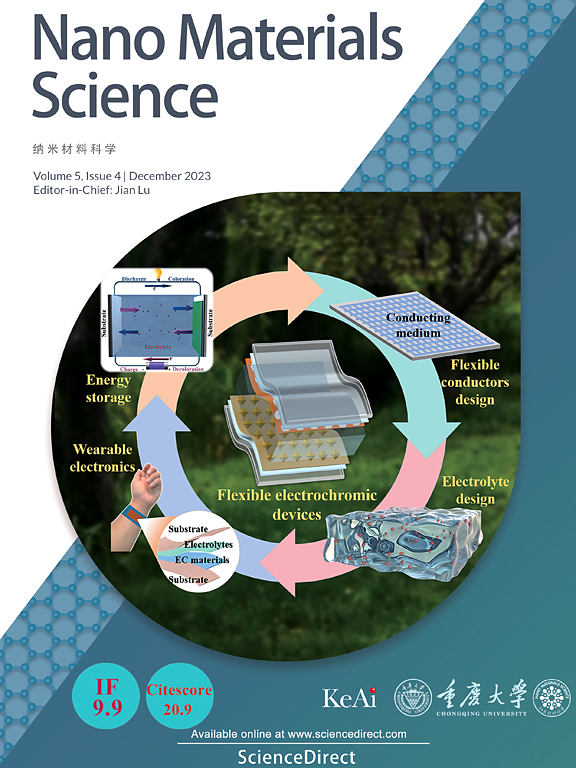光致自杀菌聚丙烯/氧化锌/聚多巴胺- tempo复合膜
IF 17.9
2区 材料科学
Q1 Engineering
引用次数: 0
摘要
口罩在预防感染传播方面发挥着关键作用。然而,在口罩中捕获感染源颗粒带来了与重复使用有关的挑战,需要适当处理。我们开发了一种可自消毒的聚丙烯基口罩膜,以应对与感染传播预防相关的挑战。该膜是用3D打印技术制造的,通过氧化锌(ZnO)和聚多巴胺(PDA)-TEMPO进行功能化,实现广谱光吸收,并通过光催化和光热效应在光照射下促进自杀菌。疏水表面(水接触角为133±2°)最大限度地减少了水分积累,并且膜具有强大的力学性能,包括抗剪强度(1.25±0.5 kPa)和抗剥离强度(112.8±11.2 kPa)。评估表明,气流稳定性(0-500 cm3/s),对颗粒物(PM 0.3, PM 2.5, PM 10)的气溶胶过滤效率(94.8±0.6%)与商用口罩相当。该膜在模拟呼吸环境中显示出五次以上的抗菌效果。安全性评估通过细胞相容性和皮肤刺激试验证实了生物相容性。总之,这种膜提供了高效的过滤和光触发杀菌,为下一代口罩提供了一个有前途的解决方案,以解决与重复使用、处理和感染控制有关的问题。本文章由计算机程序翻译,如有差异,请以英文原文为准。
Photo-responsive polypropylene/zinc oxide/polydopamine-TEMPO composite membranes with light-induced self-sterilization
Face masks play a pivotal role in preventing infection transmission. However, the capture of infection-sourced particles in face masks poses challenges related to reuse, necessitating proper disposal. We developed a self-sterilizable polypropylene-based membrane for face masks to address challenges associated with infection transmission prevention. The membrane, created using 3D printing, underwent functionalization with zinc oxide (ZnO) and polydopamine (PDA)-TEMPO to achieve broad-spectrum light absorption and facilitate self-sterilization through photocatalytic and photothermal effects upon light exposure. The hydrophobic surface (water contact angle: 133 ± 2°) minimized moisture accumulation, and the membrane exhibited robust mechanical properties, including shear strength (1.25 ± 0.5 kPa) and peel resistance strength (112.8 ± 11.2 kPa). The evaluation demonstrated stability in airflow (0–500 cm3/s) and excellent aerosol filtration efficiency (94.8 ± 0.6 %) for particles (PM 0.3, PM 2.5, PM 10), comparable to commercial masks. The membrane showed antibacterial efficacy over five uses in a simulated respiratory environment. Safety assessments confirmed biocompatibility through cytocompatibility and skin irritation assays. In conclusion, this membrane offers efficient filtration and photo-triggered sterilization, presenting a promising solution for next-generation face masks to address concerns related to reuse, disposal, and infection control.
求助全文
通过发布文献求助,成功后即可免费获取论文全文。
去求助
来源期刊

Nano Materials Science
Engineering-Mechanics of Materials
CiteScore
20.90
自引率
3.00%
发文量
294
审稿时长
9 weeks
期刊介绍:
Nano Materials Science (NMS) is an international and interdisciplinary, open access, scholarly journal. NMS publishes peer-reviewed original articles and reviews on nanoscale material science and nanometer devices, with topics encompassing preparation and processing; high-throughput characterization; material performance evaluation and application of material characteristics such as the microstructure and properties of one-dimensional, two-dimensional, and three-dimensional nanostructured and nanofunctional materials; design, preparation, and processing techniques; and performance evaluation technology and nanometer device applications.
 求助内容:
求助内容: 应助结果提醒方式:
应助结果提醒方式:


